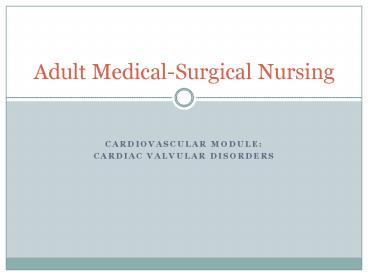Cardiovascular Module: - PowerPoint PPT Presentation
1 / 27
Title:
Cardiovascular Module:
Description:
Adult Medical-Surgical Nursing CARDIOVASCULAR MODULE: CARDIAC VALVULAR DISORDERS The cardiac valves are: Aortic Pulmonary Mitral Tricuspid ... – PowerPoint PPT presentation
Number of Views:149
Avg rating:3.0/5.0
Title: Cardiovascular Module:
1
Adult Medical-Surgical Nursing
- Cardiovascular Module
- Cardiac Valvular Disorders
2
Cardiac Valvular Disorders Description
- The cardiac valves are
- Aortic
- Pulmonary
- Mitral
- Tricuspid
- Disorders lead to poor blood flow through the
heart, and may lead to ? cardiac output
3
Cardiac Valvular Disorders Classification
- Stenosis
- Incompetence
4
Cardiac Valve Stenosis
- Narrowing of the valve
- Increases demand on the myocardium to pump blood
through the valve
5
Cardiac Valve Incompetence
- Incompetence/ regurgitation
- A damaged valve which leaks and does not close
properly - Leads to
- Backflow of blood during systole and increased
back pressure - ? cardiac output
6
Cardiac Valvular Disorder Aetiology
- Congenital
- Ageing wear and tear
- Rheumatic heart disease or bacterial
endocarditis - An auto-immune response following Rheumatic fever
(less common now) or streptococcal throat
infection - ? endocarditis and chronic bacterial vegetation
around valve/ valves
7
Cardiac Valvular Disorder Diagnosis
- History and clinical findings
- Chest Xray
- ECG
- Echocardiography
- Cardiac catheterisation reveals degree of
closure / incompetence
8
Prevalent Conditions
- Mitral stenosis
- Mitral incompetence
- Aortic stenosis
- Aortic incompetence
9
- Mitral Stenosis
10
Mitral Stenosis Pathophysiology
- Narrowing of mitral valve
- This causes left atrium to force blood to left
ventricle - ? dilatation/ hypertrophy of left atrium
- Atrial fibrillation risk of thrombus/ emboli
- Backflow/ congestion in pulmonary circulation
leads to - Increased workload of right ventricle ?
- Right heart failure
11
Mitral Stenosis Clinical Manifestations
- Fatigue/ dizziness (low cardiac output)
- Respiratory problems
- Dyspnoea, cough, frequent chest infections,
haemoptysis - Atrial fibrillation (dysrythmia) weak often
irregular pulse (risk of emboli) - Diastolic murmur on auscultation
12
Mitral Stenosis Medical Management
- Treat congestive heart failure
- Diuretics, Digoxin, vasodilators (reduce
afterload) - Anti-dysrythmics
- Anticoagulants (longterm to prevent emboli)
- Antibiotics prior to dental or surgical
procedures (to prevent endocarditis)
13
Mitral Stenosis Surgery
- Valvotomy
- Valve replacement
- An animal or human valve
- An artificial valve (prosthesis)
- With an artificial valve long-term
anticoagulants required (risk of thrombus)
14
- Mitral Incompetence
15
Mitral Incompetence Pathophysiology
- The mitral valve does not close and leaks
causing - Backflow of blood during systole from left
ventricle to left atrium - ? cardiac output is reduced
- ? increased pressure, dilatation and hypertrophy
of left atrium - Pulmonary congestion ?
- Right heart failure
16
Mitral Incompetence Clinical Manifestations
- Maybe symptomless
- Fatigue and weakness
- Palpitations on exertion
- Dyspnoea and cough
- Systolic murmur at apex on auscultation
17
Mitral Incompetence Surgery
- Surgical intervention is necessary as
progressively cardiac output is reduced and
pulmonary congestion increased - Valvuloplasty (repair)
- Valve replacement
- Medical management of symptoms
18
- Aortic Stenosis
19
Aortic Stenosis Pathophysiology
- Narrowing of the aortic valve
- Causes increased filling and effort of the left
ventricle (forcing blood through) ? - Left ventricular hypertrophy
- Left ventricular failure (maybe acute pulmonary
oedema)
20
Aortic Stenosis Clinical Manifestations
- Faintness/ dizziness (low cardiac output)
- Angina
- O2 demand of hypertrophied left ventricle
- Slow forceful systole reduces diastole and
filling time for coronary circulation - Dyspnoea
- If LVF
- Copious blood-stained frothy sputum
21
Aortic Stenosis Auscultation
- Loud systolic murmur over aortic area and
vibration of turbulent blood felt by a hand over
the apex
22
Aortic Stenosis Management
- Medical
- Treat angina and symptoms of LVF
- Vasodilators, Digoxin, diuretics, anticoagulants
- Antibiotics prior to dental work or surgery to
prevent endocarditis - Surgery
- Valvotomy
- Valve replacement
23
- Aortic Incompetence
24
Aortic Incompetence Pathophysiology
- Aortic valve is damaged and leaking
- Blood regurgitates from aorta during diastole
into left ventricle ? dilatation - Left ventricle hypertrophies to force emptying
into the aorta - ? increased systolic BP
- Arterial vasodilatation to compensate
- (? peripheral resistance) ? diastolic BP
- (? pulse pressure) ? LVF
25
Aortic Incompetence Clinical Manifestations
- Forceful heartbeat
- Dyspnoea on exertion and fatigue
- Paroxysmal nocturnal dyspnoea and orthopnoea (may
lead to LVF) - ? pulse pressure, water-hammer pulse (rapid
strong pulse which then collapses) - Diastolic murmur on auscultation
26
Aortic Incompetence Management
- Medical management of LVF
- Antibiotic cover for dental or surgery to prevent
endocarditis - Surgery Aortic valve replacement
- (This is the preferred management)
- Anticoagulants long-term if artificial valve
27
Nursing Responsibilities
- Physical examination
- ECG monitoring
- Weight, vital signs, fluid balance
- ICU nursing post-surgery
- Patient education on diet, degree of exercise and
rest, medications - Psychological/ emotional support































